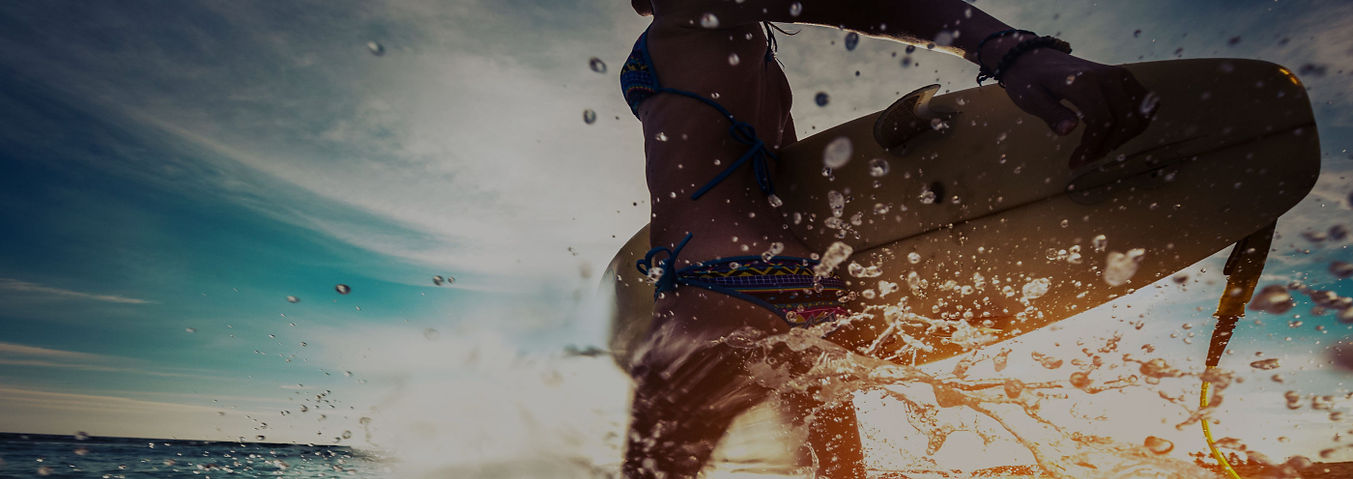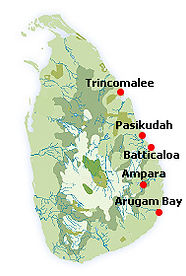
ARUGAM BAY
Arugam is a small fishing village on the East Coast of Sri Lanka. The discovery of the bay by surfers has made Arugam Bay one of the sought after surfing spots in Sri Lanka tourism.The beautiful bay with its gorgeous sweeping sand with amazing swells and long consistent breaks is one of the top ten surfing destinations in the world.The spectacular view, the sugar sandy beaches and the surroundings tropical forests with choice wild life gives it an ambience that falls a little short of being extravagantly exotic.This makes it a perfect place to unwind and allow the sea to seduce you in to snorkeling, swimming and surfing with a sigh of satisfaction that you planned your holiday well.The surfers will find three points on the stretch of beach that attracts surfers from around the world from April to October.Pottuvil Point which is an hour and a half away by a cab or a tuk tuk is considered by seasoned surfers to be out of a dream of. It is a deserted stretch of sandy beach strewn with huge boulders at the edge.
Arugam Point is the main break at Arugam Bay and attracts the most number of surfers during the surfing season.Crocodile Rock is the third and the last of the three. An added attraction here is the possibility of your sighting crocodile, water buffalo, elephant, peacock, eagle or kingfishers that frequent the lagoon. This surfer’s paradise has side walk cafes that serve delicious rice and curry and accommodation ranging from luxury holiday resorts to cheap Sri Lanka holidays. Any Sri Lanka Tailor made holiday which includes Arugam Bay is a sure experience, be it for surfing or relaxation.

Arugam Bay Information and Google Map
PROVINCE : EASTERN PROVINCE
DISTRICT : AMPARA DISTRICT
POPULAR : BEACH,SURFING,RELAX
WEATHER : 32 °C
PHOTO GALLERY
Historical Background
Trincomalee, referred to as `Trinco’, is blessed with the world's deepest and largest natural harbour. Colonial powers battled for this strategic port beginning with the Portuguese in the 17C, followed by the Dutch and the British. During World War II, Trincomalee was a British naval base and still continues to be used by the Sri Lankan Navy.
The history of the central and south east region dates back to the ancient Ruhunu Kingdom of the 3C BC. The Deegawapi Archeological museum exhibits findings of this period. This beautiful region has undergone much hardship in the past as a result of 26-years of terrorism waged by the LTTE as well as the devastating Boxing Day Tsunami in 2004. Terrorism was eradicated from the island in 2009. Recovery is well underway, making it once again an appealing holiday destination.
Shopping
Trincomalee has several small shops and markets as well as a few internet cafes and banks. For local handicrafts made of Palmyrah Palm, head to Batticaloa which is about an hour south of Pasikudah. Browse the Batticaloa market on Lady Manning Drive for fresh seafood, homegrown vegetables and fruits. Arugam Bay's main strip has several internet cafes, surf shops, wayside clothing shops selling beach shorts to batik t-shirts, grocery shops, a Food City where you can buy toiletries, soft drinks, bottled water; two banks, a pharmacy and post office.
Events
Whale & Dolphin spotting in Trinco: The East Coast season for whale and dolphin spotting is from about March to September.
Surfing in Arugam Bay: Listed as one of 10 best surf spots in the world, Arugam Bay comes alive each July and August which is the surfing season. The UK Pro-Surfing Association’s Sri Lanka Surf Championships are held each year in Arugam Bay in July.
Climate
Sri Lanka’s east coast comes into its own while the rest of the island is experiencing monsoonal rains. The best weather is from April to September, with the monsoon running from October until January. Sri Lanka is affected by two separate monsoons which generally means that there is usually good weather somewhere. Essentially the main south-west (“yala”) monsoon brings rain to the west and south-west coasts and hill country largely between May and July. The less severe north-east (“maha”) monsoon hits the east coast – including the cultural triangle - predominantly from November to January. There is also an inter-monsoonal period of unsettled weather preceding the Maha monsoon in October during which heavy rainfall can occur anywhere across the island.
Sights
Arugam Bay: Arugam Bay is Sri Lanka at its most escapist. The relatively isolated beaches and a simple, laid-back lifestyle, away from the main tourist haunts, have many devotees. A' Bay offers high-class surfing (the best on the island) and deserted beaches. Surfing season is from about mid-May to August. Go on a jeep safari and explore the jungles of Lahugala National Park.
Batticaloa & Ampara: Visit Batticaloa’s 17C Dutch Fort, go bird watching by the lagoon or stroll on Kalladi Beach. Travelling further south, you reach Ampara – dotted with lush green paddy fields, Palmyrah trees and tranquil lagoons.
Gal Oya National Park: An extensive wildlife sanctuary edged by a lake that is inhabited by herds of elephants, water buffalo, deer and crocodile. Go on a boat safari.
Kumana National Park: The swamp lakes of Kumana, also known as Yala East National Park, are nesting sites for water birds from June onwards. The jungles are also home to wild elephants, buffalo and deer. Often the endangered marine turtles come ashore to nest on secluded beaches. The main entrance to Kumana is in Okanda, south of Arugam Bay. Best time to visit is at dawn and late afternoon.
Maligawila Buddha statues: Situated south of Monaragala en route to Pottuvil, the Maligavila Buddha is the largest freestanding image of Lord Buddha in Sri Lanka. Carved out of a single block of limestone, this statue was discovered in fragments and restored in 1980.
Pasikudah: Pasikudah and Kalkudah are fast recovering their popularity in the 1980s as a beach destination but with a more upmarket feel. Now several boutique hotels line the bay and offer a range of watersports from jet skiing to catamaran sailing. Take a bicycle ride inland. Bird watching in Vakarai lagoon about 45 minutes north.
Trincomalee: Sri Lanka’s equivalent to the Maldives, Trinco’s never-ending white sandy beaches, coral islands and shimmering blue seas are distinctly different from the coastal areas of the rest of the island. Bask in the sun on the secluded beaches of Uppuveli, Nilaveli & Kuchchaveli to the north of town. Discover the magnificent marine life around Pigeon Island or go on a dolphin and whale-watching excursion into the deep seas. Trincomalee’s natural harbour - considered to be the finest in the world, can be viewed from Fort Frederick. Past Fort Frederick is Swami Rock also referred to as 'Lover's Leap'.

Activities




I'm a paragraph. Click here to add your own text and edit me. It's easy.
Batticoloa by Bike
Cycle along Batticaloa’s narrow lanes and get a taste of rural Sri Lankan life. Along the way, stop off at a Shiva temple, organic farm and handloom factory to see one of the island’s ancient crafts.
Gal Oya National Park
Gal Oya is one of the most remote and stunning national parks in Sri Lanka. Inclusive of the largest reservoir in the island, take a boat safari at sunset as well as doing a morning game drive.
A scenic and challenging course near Trincomalee Harbour on Sri Lanka’s east coast which offers stunning ocean views and is just a 15-minute drive from the pristine Marble Beach.
Eagles' Golf Links
Okanda Hindu Kovil
An ancient Hindu shrine located on a rocky outcrop which is an important resting place for Hindu pilgrims travelling on the ‘Pada Yatra’ to Kataragama.
Koneswaram Kovil
The newly-restored Koneswaram Kovil, the original of which was built in 205 BC, is poised on a sheer cliff which stands 350ft above sea level and offers stunning views over Trinco’s natural harbour.








